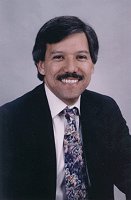
Spring/Summer 1999
Volume 6, Issue 2
Spring/Summer 1998
Volume
3, Issue 1
January 1995
Volume
2, Issue 4
October 1994
Volume
2, Issue 1
January 1994
 |
EAC Focus - Juan C. MezaDistributed Computing Manager, Sandia National Laboratories, Livermore, California
|
Juan C. Meza's research interests are in the areas of parallel nonlinear optimization problems and the development of algorithms for computational engineering problems. His current work at Sandia National Laboratories involves object-oriented nonlinear optimization (OPT++) libraries, optimal control and design, and advanced geophysical inverse modeling.
"I became interested in these problems as a result of conversations with engineers within Sandia," says Meza. "These problems are of extreme importance to many applications here, yet they were rarely approached as optimization problems. By approaching them from a more mathematical viewpoint, we've been able to speed up the analysis and design phases substantially and derive better designs at the same time."
Meza was born in Houston, Texas and moved to Mexico with his family several years later. The oldest of five siblings, he spent four years living in Monterrey and Mexico City before moving back to Houston to complete his education. He graduated from Milby High School in 1974 and then chose to attend Rice University to achieve his lifelong dream of becoming an engineer.
"I went to Rice for five years and finished with an M.S. in electrical engineering in 1979," he says. "Like many of the students I know today, I couldn't wait to go out and start making money. I moved to California to work for Amdahl Corporation as a systems design engineer and later moved back to Houston to work for Exxon Production Research as a research engineer. After two years of work, I decided that what I really wanted to do was research, so I went back to Rice to pursue a Ph.D. in mathematical sciences."
Meza received his Ph.D. in 1986 and worked as a lecturer and research associate at Rice before joining Sandia National Laboratories in 1987. During his nine-year tenure as a senior member of the technical staff, Meza served as project manager for several research projects, including one in parallel opimization methods for manufacturing and another on 3D geophysical inverse modeling. He also developed a semiconductor device simulation code for the modeling of single-event upset phenomenon.
In 1996, Meza became a distinguished member of Sandia's technical staff, an award that is granted to only 10 percent of the technical staff at any given time. He currently leads the Common Basic Environment Project for the ASCI Problem Solving Environment program. This project involves the development of a software environment that can be used across all three of the ASCI platforms. In addition, he leads Sandia's efforts in the Department of Energy (DOE) DOE2000 Advanced Computational Testing and Simulation (ACTS) program and is a principal investigator for the Mathematical, Information, and Computational Sciences project on Large-Scale Optimization for Scientific and Engineering Design Optimization.
Earlier this year, Meza was named Manager of Distributed Computing at Sandia. He is now helping to develop a Distance/Distributed Computing program plan and a Verification and Validation program plan. He also serves as technical liaison to the DOE Strategic Alliances program for the Stanford Center for Integrated Turbulence Simulations.
Meza is a member of many professional societies and committees, including the Parallel Tools Consortium Steering Committee; American Mathematical Society (AMS)-Society for Industrial and Applied Mathematics (SIAM) Committee; Mathematical Association of America (MAA) Committee on Advising; MAA Committee on Materials on Careers; and Science in California Communities Informal Science Education Advisory Board. He is the editor of the SIAM Special Interest Group in Optimization Views and News Newsletter in 1996, and has been the editor of the SIAM Special Interest Group in Linear Algebra Electronic Newsletter. Meza has been a member of the CRPC External Advisory Committee since 1996.
"The most impressive feature that I've found about the CRPC is not only that the technical output has been first rate, but that the education outreach components have been so outstanding. There are few places that can claim the kind of impact that the CRPC has attained in the area of education, particularly with regard to participation from women and underrepresented minorities in the sciences."
Meza's honors and awards include a National Merit Scholarship (1974-1978),
Tau Beta Pi Engineering Honor Society, IBM Fellowship (1982-1983), Sandia
Award for Excellence (1993), Sandia Employee Recognition Award (1995), and
Sandia National Laboratories Royalty Award (1996). He is the author or
co-author of more than 20 publications and technical papers.